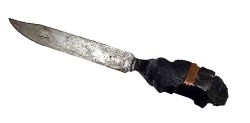Pavel Habáň
Despite the well-known Latin saying that “when arms are speaking, muses are silent“ this is not necessarily the case. To this fact attest artworks created by soldiers in WWI. that are present in museum collections of militaria in Slovakia. For the soldiers, these extraordinary artefacts were a way to escape from the harsh wartime reality giving them hope of connecting with a normal life, relaxation with thoughts about their homes, family and everything dear to them. They also had a memorial function. They are characterised by documentary accuracy as they recorded the event or historical circumstances in which they were created and they carry the imprint of their authors. Specific contexts of their origin were the conditions of the trench war, months of waiting on the warfront line in extreme situations with limited material possibilities. Hence, the warfront artists created their works from available durable materials from used ammunition.
The preserved artefacts show that the material most frequently used for artwork were brass canon and rifle cartridges, insulation stripes, timers, but also artillery grenade shells. From them, soldier created various decorative objects – mostly vases, paper weights and ink wells. They were visually appealing, as when polished they looked like made from gold. The soldiers also made desktop or wall photograph frames, ashtrays, lighters, but also more demanding “artefacts” such as cigarette boxes, candleholders, inkwells even complete writing sets with photograph frames and letter holders.
